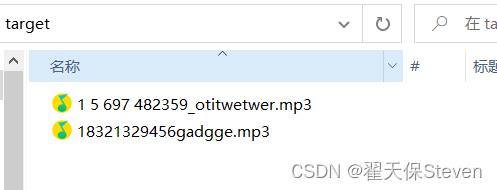C++-筛选文件夹中符合要求的文件并拷贝出来(以手机号码查找为例)
Posted 翟天保Steven
tags:
篇首语:本文由小常识网(cha138.com)小编为大家整理,主要介绍了C++-筛选文件夹中符合要求的文件并拷贝出来(以手机号码查找为例)相关的知识,希望对你有一定的参考价值。
作者:翟天保Steven
版权声明:著作权归作者所有,商业转载请联系作者获得授权,非商业转载请注明出处
场景需求
在日常工作中,必然会和各类文件打交道,如何高效地操作处理文件是提高工作效率的关键。Excel、VB、Python等等用好了,都可以将傻瓜操作(批量复制粘贴、筛选查找等)自动化,仅需秒级时间,即可完成他人小时级时间的工作量,剩下的时间至于是摸鱼还是自主学习,就看个人了。由此可见,高效的工作方法选对了是多么重要。
本文所要实现的需求:有一文件夹A,大概有千级往上数量的录音文件,每个录音文件名格式为“手机号码+乱码.xxx”;手头另有一号码表格B,存放了200个左右的11位手机号码。要求将文件夹A中号码与表格B号码匹配的录音,拷贝到另一文件夹C中。
如果用EXCEL,可以借助VLOOKUP,完成筛选,再用Bat的copy指令,完成拷贝操作。(方法多种多样,有其他思路的欢迎评论区留言,一同交流学习)
那如何用C++实现,本文将进行详细的讲解,提供源码和简易测试代码。(实现方法同样多种多样,本文仅用了一种方案,仅供参考)
解决思路
要想完成该功能,可以拆分一下各个子功能。
- 第一步要做的是将文件夹A中后缀为xxx的文件先提取出来。
- 第二步是将表格B中的号码提取出来。
- 第三步是匹配,也是关键步骤。将A中与B匹配的录音筛选出来,只有满足要求才能拷贝,其他的直接跳过。该步骤也是大家可以自定义匹配规则的一步,根据自己需求设计。
具体实现
1)我们将文件夹A的路径用字符串from存储下来,文件夹C的路径用字符串to存储下来,同时定义一个表格B的路径。
string from = "C:\\\\Users\\\\Administrator\\\\Desktop\\\\current\\\\";
string to = "C:\\\\Users\\\\Administrator\\\\Desktop\\\\target\\\\";
string sheetpath= "C:\\\\Users\\\\Administrator\\\\Desktop\\\\current\\\\test.txt";2)设计一个getFiles函数,用于获取目标文件夹下目标文件信息,并存放在vector中。
// 获取目标文件夹下目标文件信息
void getFiles(std::string path, vector<std::string>& files, vector<std::string>& filesname, std::string suffix)
intptr_t hFile = 0;
struct _finddata_t fileinfo;
string p;
// 寻找当前文件夹下后缀为mp3的文件
if ((hFile = _findfirst(p.assign(path).append(suffix).c_str(), &fileinfo)) != -1)
do
// files存放文件全路径
files.push_back(p.assign(path).append(fileinfo.name));
// filesname存放文件名
filesname.push_back(fileinfo.name);
while (_findnext(hFile, &fileinfo) == 0); // _findnext若匹配成功返回0,不成功返回-1
_findclose(hFile);
3)设计一个getNumber函数,用于获取表格B中的号码信息,用于后期匹配。
// 获取数字表
vector<string> getNumber(string sheetpath)
vector<string> numbers;
ifstream infile(sheetpath);
string str;
// 一行行读取
while (getline(infile, str))
string temp = str.substr(0, 11);
numbers.push_back(temp.c_str());
// 关闭
infile.close();
return numbers;
4)设计一个copyFile函数,用于将文件M拷贝到另一路径中。
// 复制文件
void copyFile(char* tfrom, char* tto)
// 打开
FILE* fpread = fopen(tfrom, "rb"); // 读
FILE* fpwrite = fopen(tto, "wb"); // 写
if (fpread == NULL)
cout << "error: read error." << endl;
return;
if (fpwrite == NULL)
cout << "error: write error." << endl;
return;
// 读写操作
char* p;
p = (char*)malloc(sizeof(char)); // 为指针申请内存空间
while (!feof(fpread)) // feof()检测光标后是否还有内容 没有则返回非0
fread(p, sizeof(char), 1, fpread);
fwrite(p, sizeof(char), 1, fpwrite);
if (p != NULL)
free(p);
p = NULL;
// 关闭
fclose(fpread);
fclose(fpwrite);
return;
5)设计一个isMatch函数,用于匹配。如果你有自己其他的匹配需求,可以更改该函数。我这里只进行了一个去空格和寻找的操作。
// 匹配字符串
bool isMatch(string filename, vector<string> sheet)
// 去除空格
int i = int(filename.find(" ", 0));
while (i != string::npos)
filename.replace(i, 1, "");
i = int(filename.find(" ", 0));
// 取前11位号码
string number = filename.substr(0, 11);
// 寻找是否在库中
vector<string>::iterator it = find(sheet.begin(), sheet.end(), number);
if (it == sheet.end())
return false;
else
return true;
6)用identifyFiles函数将上述功能简单封装一下。若输出文件夹不存在,创建一个;获取符合要求的文件的信息;获取表格B的号码;循环匹配,匹配成功,执行拷贝。
// 识别文件
void identifyFiles(std::string from, std::string to, std::string sheetpath, std::string suffix)
vector<std::string> files;
vector<std::string> filesname;
// 如果文件夹不存在,则创建
if (_access(to.c_str(), 0) == -1)
int re = _mkdir(to.c_str());
// 获取符合要求文件的信息
getFiles(from, files, filesname, suffix);
// 获取数字表
vector<string> numbers = getNumber(sheetpath);
// 识别
int size = int(files.size());
char* tf = new char[256];
char* tn = new char[256];
std::string target;
for (int i = 0; i < size; i++)
// 若匹配成功则拷贝,失败则跳过
if (isMatch(filesname[i], numbers))
target = to + filesname[i];
strcpy(tf, files[i].c_str());
strcpy(tn, target.c_str());
copyFile(tf, tn);
// 释放指针
if (tn != NULL)
free(tn);
tn = NULL;
if (tf != NULL)
free(tf);
tf = NULL;
return;
7)以上就是该功能实现的整个思路。
C++完整代码及测试案例
#include <iostream>
#include <stdlib.h>
#include <io.h>
#include <vector>
#include <stdio.h>
#include <string>
#include <cstring>
#include <vector>
#include <sstream>
#include <fstream>
#include <direct.h>
#pragma warning(disable:4996)
using namespace std;
// 匹配字符串
bool isMatch(string filename, vector<string> sheet)
// 去除空格
int i = int(filename.find(" ", 0));
while (i != string::npos)
filename.replace(i, 1, "");
i = int(filename.find(" ", 0));
// 取前11位号码
string number = filename.substr(0, 11);
// 寻找是否在库中
vector<string>::iterator it = find(sheet.begin(), sheet.end(), number);
if (it == sheet.end())
return false;
else
return true;
// 复制文件
void copyFile(char* tfrom, char* tto)
// 打开
FILE* fpread = fopen(tfrom, "rb"); // 读
FILE* fpwrite = fopen(tto, "wb"); // 写
if (fpread == NULL)
cout << "error: read error." << endl;
return;
if (fpwrite == NULL)
cout << "error: write error." << endl;
return;
// 读写操作
char* p;
p = (char*)malloc(sizeof(char)); // 为指针申请内存空间
while (!feof(fpread)) // feof()检测光标后是否还有内容 没有则返回非0
fread(p, sizeof(char), 1, fpread);
fwrite(p, sizeof(char), 1, fpwrite);
if (p != NULL)
free(p);
p = NULL;
// 关闭
fclose(fpread);
fclose(fpwrite);
return;
// 获取目标文件夹下目标文件信息
void getFiles(std::string path, vector<std::string>& files, vector<std::string>& filesname, std::string suffix)
intptr_t hFile = 0;
struct _finddata_t fileinfo;
string p;
// 寻找当前文件夹下后缀为mp3的文件
if ((hFile = _findfirst(p.assign(path).append(suffix).c_str(), &fileinfo)) != -1)
do
// files存放文件全路径
files.push_back(p.assign(path).append(fileinfo.name));
// filesname存放文件名
filesname.push_back(fileinfo.name);
while (_findnext(hFile, &fileinfo) == 0); // _findnext若匹配成功返回0,不成功返回-1
_findclose(hFile);
// 获取数字表
vector<string> getNumber(string sheetpath)
vector<string> numbers;
ifstream infile(sheetpath);
string str;
// 一行行读取
while (getline(infile, str))
string temp = str.substr(0, 11);
numbers.push_back(temp.c_str());
// 关闭
infile.close();
return numbers;
// 识别文件
void identifyFiles(std::string from, std::string to, std::string sheetpath, std::string suffix)
vector<std::string> files;
vector<std::string> filesname;
// 如果文件夹不存在,则创建
if (_access(to.c_str(), 0) == -1)
int re = _mkdir(to.c_str());
// 获取符合要求文件的信息
getFiles(from, files, filesname, suffix);
// 获取数字表
vector<string> numbers = getNumber(sheetpath);
// 识别
int size = int(files.size());
char* tf = new char[256];
char* tn = new char[256];
std::string target;
for (int i = 0; i < size; i++)
// 若匹配成功则拷贝,失败则跳过
if (isMatch(filesname[i], numbers))
target = to + filesname[i];
strcpy(tf, files[i].c_str());
strcpy(tn, target.c_str());
copyFile(tf, tn);
// 释放指针
if (tn != NULL)
free(tn);
tn = NULL;
if (tf != NULL)
free(tf);
tf = NULL;
return;
int main()
string from = "C:\\\\Users\\\\Administrator\\\\Desktop\\\\current\\\\";
string to = "C:\\\\Users\\\\Administrator\\\\Desktop\\\\target\\\\";
string sheetpath= "C:\\\\Users\\\\Administrator\\\\Desktop\\\\current\\\\test.txt";
cout << "start:" << endl;
cout << " from:" << from << endl;
cout << " to:" << to << endl;
cout << " dictionary:" << sheetpath << endl;
// 识别文件
identifyFiles(from, to, sheetpath, "\\\\*.mp3");
cout << "end." << endl;
return 0;
测试效果




在测试案例中,我创建了一些mp3文件,并仿照需求进行命名,test.txt作为表格B。实测下来,getFiles函数可以做到只存储特设后缀的文件信息,并且匹配功能也能成功适应带空格的命名情况。
如果函数有什么可以改进完善的地方,非常欢迎大家指出,一同进步何乐而不为呢~
如果文章帮助到你了,可以点个赞让我知道,我会很快乐~加油!
以上是关于C++-筛选文件夹中符合要求的文件并拷贝出来(以手机号码查找为例)的主要内容,如果未能解决你的问题,请参考以下文章